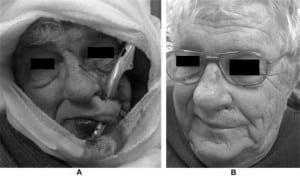| Author | Affiliation |
|---|---|
| Joel T. Levis, MD, PhD | Kaiser Santa Clara Medical Center, Department of Emergency Medicine, Santa Clara, CA |
| Jodie Craig, MD | Kaiser Santa Clara Medical Center, Department of Emergency Medicine, Santa Clara, CA |
A 75-year-old male presented to the emergency department (ED) following a fall from his bicycle. The patient fell face-first onto the handlebars, with the brake handle impaling his left upper lip. Paramedics were able to detach the handle from the bicycle and transport him to the ED. He denied loss of consciousness, neck pain, dental pain, or other injuries. Examination revealed the brake handle protruding through his upper lip just inferior to the nasal labial fold (Figure, panel A). No other intraoral trauma was noted, and bleeding was minimal. The ED physician carefully extracted the brake handle from the wound, revealing a 2.5 cm linear laceration. Regional anesthesia was accomplished using an infraorbital nerve block (1:1 mixture of lidocaine: bupivicaine). The wound was irrigated with sterile saline, and repaired using four subcutaneous 4.0 absorbable sutures followed by 6–6.0 nylon skin sutures (Figure, panel B). The patient’s tetanus immunization was updated, and he was discharged with instructions to return in seven days for suture removal.

Impalement injuries result from penetration by a rigid, blunt-tipped object that traverses a body area in a through-and-through fashion.1 Facial impalement injuries are less common than injuries to the trunk or extremities due to the smaller target size of the face, and protective reflexes that tend to move the face away from coming objects.2 In cases of oral impalement injuries, care must be taken in removing the foreign body in the event that the object is providing a tamponade effect and preventing significant bleeding, particularly if the labial artery is involved. Anesthesia of oral wounds should be accomplished using a regional nerve block (infraorbital nerve block for the maxillary lip) to prevent tissue distortion.3 Through-and-through lip or oral lacerations should be closed using a layered approach.
Footnotes
Supervising Section Editor: Sean Henderson, MD
Submission history: Submitted December 15, 2009; Accepted December 29, 2009
Full text available through open access at http://escholarship.org/uc/uciem_westjem
Address for Correspondence: Joel T. Levis, MD, PhD, FACEP, FAAEM, Department of Emergency Medicine, Kaiser Santa Clara Medical Center, 700 Lawrence Expressway, Santa Clara, CA 95051
Email: joellevis@yahoo.com
Conflicts of Interest: By the WestJEM article submission agreement, all authors are required to disclose all affiliations, funding sources, and financial or management relationships that could be perceived as potential sources of bias. The authors disclosed none.
REFERENCES
1. Arahiro K, Ishida K, Fujii N. Unusual facial impalement injury. Plast Reconst Surg. 2001;108:145–7. [PubMed]
2. Eppley BL. Craniofacial impalement injury: a rake in the face. J Craniofac Surg. 2002;13:35–7.[PubMed]
3. Armstrong BD. Lacerations of the mouth. Emerg Med Clin North Am. 2000;18:471–80. [PubMed]


